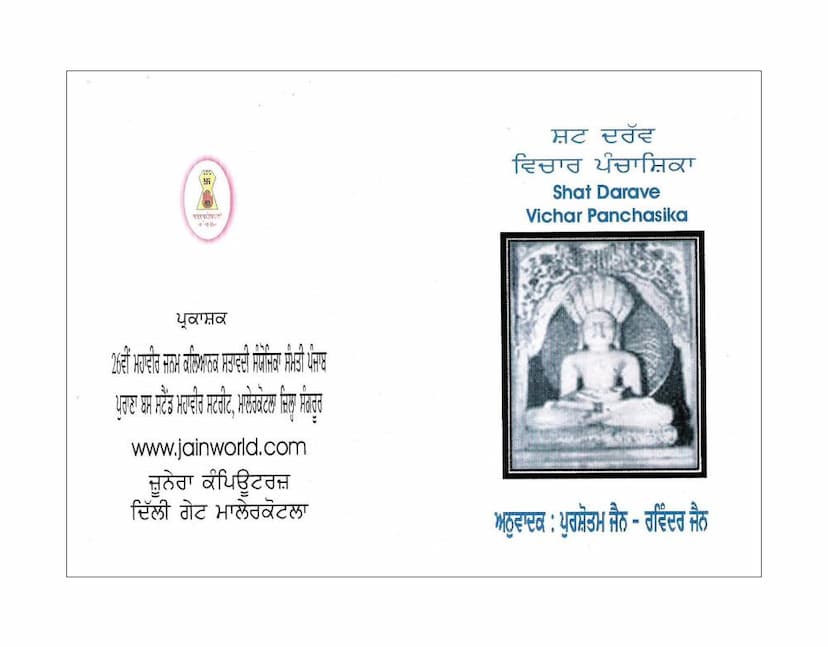Shat Dravya Panchashika
Added to library: September 2, 2025

Summary
Here's a comprehensive summary of the Jain text "Shat Dravya Panchashika" (Six Substance Compendium) in English, based on the provided pages:
Title: Shat Dravya Vichar Panchasika (A Compendium of Thought on the Six Substances) Authors: Purushottam Jain, Ravindra Jain (Translators) Publisher: Purushottam Jain, Ravindra Jain Catalog Link: https://jainqq.org/explore/009431/1
Overview:
The "Shat Dravya Panchashika" is a concise yet profound Jain text that delves into the fundamental principles of Jain philosophy, specifically focusing on the six essential substances (Dravya) that constitute reality. The text emphasizes that understanding these substances is crucial for every Jain adherent to strengthen their faith, guide their life, and ultimately achieve spiritual liberation (moksha).
Core Jain Doctrine:
The book begins by stating the fundamental principle of Jainism: the existence of only two primary elements: Jiva (soul or living being) and Ajiva (non-living matter). The entirety of Jain philosophy is built upon these two categories. Even Lord Mahavir discussed these two elements with his chief disciple, Indrabhuti Gautama, as recorded in the Bhagavati Sutra.
The Six Substances (Dravya):
The text explains that while the primary division is into Jiva and Ajiva, the Ajiva substance is further categorized into five types, making a total of six essential substances. These six substances are:
-
Jiva (Soul): Characterized by consciousness, the ability to see and know. It is described as having infinite dimensions within the universe (lokākāśa). The Jiva is further divided into pure (shuddha) and impure (ashuddha) forms.
- Pure Jiva: Possesses qualities like infinite knowledge, infinite perception, infinite energy, and eternal happiness. The liberated soul (Siddha) and the Arihant (one who has conquered inner enemies) are examples of pure Jiva.
- Impure Jiva: Trapped by karmas, it cycles through the four realms of existence (human, infernal, animal, celestial).
- Key Qualities of Jiva: Mentioned are existence (astitva), substance (vastutva), and knowability (prameyatva). It is also described as eternal (akshaya) and undergoing transformations (pariṇāma).
-
Pudgala (Matter): This is the only material substance, characterized by form and activity. It can be subtle or gross.
- Subtle Pudgala: Includes things like sound, taste, smell, and touch, which are perceived by senses other than sight. The finest, indivisible unit of matter is the paramāṇu (atom), which is imperceptible to the naked eye and only knowable through supreme clairvoyance.
- Gross Pudgala: Includes solids, liquids, and forms that are visible and tangible, created by the aggregation of paramāṇus.
- Transformations: Pudgala undergoes modifications (utpāda and vyāya) and changes in its attributes, but its fundamental substance (dhruvya) remains.
-
Dharma (Principle of Motion): This substance is formless, actionless, and exists infinitely within the universe. Its primary function is to facilitate movement for Jiva and Pudgala, much like water helps fish swim. It is described as having transformations (pariṇāma) and being responsible for the initiation of motion.
-
Adharma (Principle of Rest): This substance is also formless, actionless, and exists infinitely within the universe. Its purpose is to provide the condition for rest or stationariness for Jiva and Pudgala, similar to how shade helps weary travelers rest. It is described as aiding in maintaining a state of stillness.
-
Ākāśa (Space): This substance is all-pervading, formless, eternal, and infinite. Its essential quality is to provide space or accommodate all other substances, allowing them to exist without obstructing each other. The text distinguishes between pure space (unlimited, omnipresent) and impure space (like space within a pot or house), which are considered modifications.
-
Kāla (Time): This substance is formless, actionless, and eternal. Its fundamental characteristic is "vartana" – the process of passing or duration. Time is perceived through the changes and transformations occurring in other substances. It is responsible for concepts like "newness" and "oldness." The text explains that while time itself is constant, its manifestations in our perception (seconds, minutes, years) are behavioral aspects.
Key Concepts Explained:
- Naya (Standpoints): The text touches upon the concept of 'naya' (standpoints or perspectives) used to understand reality, distinguishing between pure (shuddha naya) and impure (ashuddha naya) perspectives.
- Pariṇāma (Modification/Transformation): All substances, except perhaps the pure soul and space, undergo modifications or transformations. This is understood through the concepts of:
- Utpāda (Generation/Creation): The coming into being of a new state or modification.
- Vyāya (Destruction/Cessation): The passing away of an old state or modification.
- Dhruvya (Permanence/Continuity): The underlying substance that remains constant despite transformations. The text illustrates this with the example of gold being shaped into different ornaments; the gold remains the same substance.
- Āstikāya: Five of the six substances (Jiva, Pudgala, Dharma, Adharma, Ākāśa) are referred to as Āstikāya, meaning they have parts or dimensions. Time (Kāla) is not an Āstikāya.
Authorship and Tradition:
The text identifies Acharya Kanjakirti as the author, inspired by Acharya Shubha Chandra. The book is rooted in the Digambara Jain tradition. It also mentions that the first translation of this text was done by Jain Acharya Hastimal Ji Maharaj.
Purpose and Significance:
The "Shat Dravya Panchasika" is presented as a foundational text for spiritual seekers. Understanding the nature of these six substances is considered essential for developing Samyaktva (right faith or perfect conviction), which is the first step towards liberation. The text encourages continuous study of its teachings for the welfare of all beings.
Acknowledgements:
The translators express gratitude to various individuals and organizations for their support in publishing this work, particularly for making Punjabi Jain literature accessible online. They also acknowledge the blessings received from numerous Acharyas and Sadhvis.